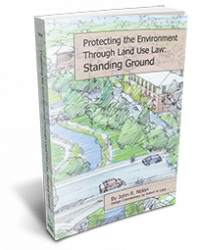Protecting the Environment Through Land Use Law: Standing Ground

John R. Nolon’s Protecting the Environment Through Land Use Law: Standing Ground takes a close look at the historical struggle of local governments to balance land development with natural resource conservation. This book updates and expands on his four previous books, which established a comprehensive framework for understanding the many ways that local land use authority can be used to preserve natural resources and environmental functions at the community level. Standing Ground describes in detail how localities are responding to new challenges, including the imperative that they adapt to and help mitigate climate change and create sustainable neighborhoods. This body of work emphasizes the critical importance of law in protecting the environment and promoting sustainable development.
Standing Ground looks at the legal foundations of local environmental law within the federal legal system, how traditional land use techniques can be used to protect the environment, and innovative and flexible methods for protecting fragile environmental areas and for making urban neighborhoods livable. Nolon examines the effects of climate change on sea level and storm surges, examining local strategies for disaster preparation, mitigation, and recovery. He discusses the growing emphasis on green infrastructure and urban agriculture as crucial strategies for fostering a healthy environment and analyzes the role of environmental impact review. The book concludes with a discussion of environmental dispute resolution and consensus-based land use decisionmaking.
CLICK HERE TO SEE THE TABLE OF CONTENTS
Standing Ground is both a call to action—challenging readers to consider how local law and policy can augment state and federal conservation efforts—and a celebration of the valuable role local governments play in protecting our environment.
When it comes to the subject of local environmental law, John Nolon is a passionate, inspirational, and authoritative guide and teacher. The rest of us—lawyers, planners, professors, judges, public officials, and citizen activists—have all benefited from his insights and have been challenged to think carefully and creatively about the ways in which local law and policy can augment and improve upon federal and state efforts to protect our fragile environment from a growing number of threats.”—Michael Allan Wolf, Richard E. Nelson Chair in Local Government Law, University of Florida Levin College of Law
“This book is committed to understanding that, in the face of new challenges, an integrated approach to environmental law that is interdisciplinary, multifaceted, and participatory is essential.”—Robert Lane, Senior Fellow for Urban Design, Regional Plan Association